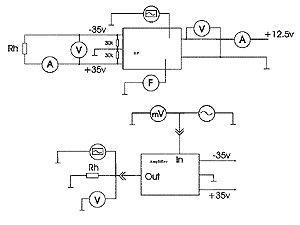
|
|
ENCYCLOPEDIA OF RADIO ELECTRONICS AND ELECTRICAL ENGINEERING Homemade amplifier on the TDA7294 chip (part 2). Encyclopedia of radio electronics and electrical engineering
Encyclopedia of radio electronics and electrical engineering / Transistor power amplifiers Part II In which there is little about me, but more about the power source. And yet - some warnings so that a home-made car amplifier does not cost more than two branded ones, and also about the fact that the transformer to calculate and wind is "nonsense" ... The first thing you should do is make a friend on the railroad. "Start" - not in a sexual sense, but in order to get hold of, at the stage of experiments, with a suitable power source of 12 V. We have a POBS-2A transformer tested by half a century of service, when consuming 30 A, its output voltage drops by half a volt. You also need an ammeter of at least 30 A, of course with a shunt, 4 diodes for the bridge (30 - 50 A) and several large rheostats. All this is on a piece of iron and with the appropriate friend will not create problems. Of the equipment you need to have: an oscilloscope, an LF generator, a frequency meter, a millivoltmeter, a bunch of testers.
How and what to connect during testing and tuning Experienced advice: it is better to make a fuse from a fuse that has blown out with long legs, which are soldered into the break + power circuit of the converter, and thin wires are first soldered to the base of the fuse, and then, when (if) everything works, their thickness gradually increases. The experimental microcircuit on which the generator was assembled is SG3524 with one field-effect transistor per shoulder. The no-load current turned out to be almost 4 A, at first he sinned on the transformer, but it turned out that the field worker, having opened, could not close, because. has residual capacity - a control circuit is needed. One of them is in front of you. FET control circuit
The scheme after opening the field worker beautifully puts it on the minus, which closes the field worker. After the introduction of the control circuit, the current x.x. on the 30-ampere scale was not observed at all. Now about the transformer. In general, during the experiments, I rewound about a hundred of them, tried to become very smart, unearthed magazines about ferrites, read, studied, even concocted two programs in Basic, one based on an article from Radio for 87, the other based on some imported reference book Now I don't remember which one. The calculation there seemed to be serious, but in the end the simplest program from Radio gave exactly the same results. Well, now I've wised up and can distinguish the hysteresis loop from the I-V-diode at least two times out of three. According to the calculation of the turns on the primary > 1, and on the secondary a little more than 1, okay, we wind up to a whole cisle, we turn on, of course, the efficiency. less than 40%, rewound, rewound, even interested some acquaintances (smart and not very smart), but they gave up, and I was again left with nothing. The program, based on an article from Radio for 87, made it possible to wind a needle around the eye and make a powerful welding machine, they say, don’t drift, everything will work like clockwork. In the context of such a powerful calculation method, I wound it using the scientific poke method, I dreamed of ferrite rings at night, one at a time and glued into a bag ... The first successful converter (the previous ones do not count) on two 2000 NM rings produced 180 W and fed one TDA 7294, which gave 95 W clean (checked at low frequencies). As soon as it turned out, I put everything in the case, connected a subwoofer and drove for a whole year. And while I was driving, I came up with a second converter circuit. It gives up to 245 W (this is my record so far). About him - in the third part. Publication: cxem.net
Machine for thinning flowers in gardens
02.05.2024 Advanced Infrared Microscope
02.05.2024 Air trap for insects
01.05.2024
▪ High Voltage 800W Laboratory Power Supplies TDK-Lambda ▪ The structure of pentaquarks has been studied ▪ Obtaining graphene from household waste
▪ section of the site For a beginner radio amateur. Article selection ▪ article Blessed is he who believes, he is warm in the world! Popular expression ▪ article Inspector at timber storage works. Standard instruction on labor protection ▪ article Thermite welding. Encyclopedia of radio electronics and electrical engineering ▪ article How to wind a transformer? Encyclopedia of radio electronics and electrical engineering
Home page | Library | Articles | Website map | Site Reviews www.diagram.com.ua |






 Arabic
Arabic Bengali
Bengali Chinese
Chinese English
English French
French German
German Hebrew
Hebrew Hindi
Hindi Italian
Italian Japanese
Japanese Korean
Korean Malay
Malay Polish
Polish Portuguese
Portuguese Spanish
Spanish Turkish
Turkish Ukrainian
Ukrainian Vietnamese
Vietnamese


 Leave your comment on this article:
Leave your comment on this article: